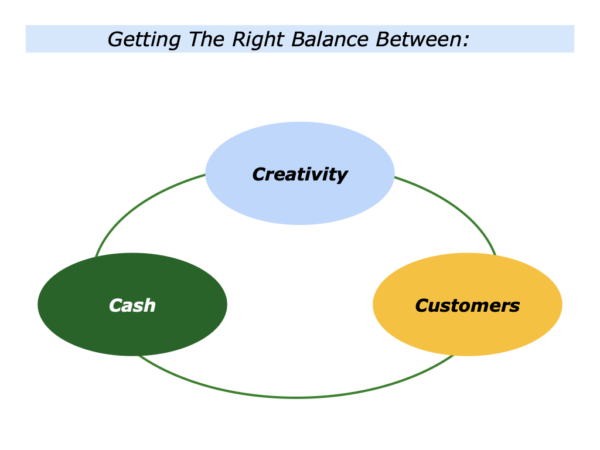
Imagine that you have many creative ideas that you want to translate into action. You may also want to earn a living by providing services or setting-up a business that helps people to succeed.
You may want to work in consultancy, technology or another field. One approach is to get the right balance between creativity, customers and cash. Let’s explore these themes.
Creativity
There are many views on creativity. Some people argue that it is hard to be truly original because many ideas have been thought of before.
Others say that creativity often emerges when applying the idea. This often calls for going through the stages of imagination, implementation and achieving impact.
What do you have ideas about? Frequently these will focus on the topics you find fascinating. These may include ideas about people, technology, business, art, sport or whatever.
Different people give different answers to this question. Over the years I have worked with people who have said the following things.
I have ideas about:
How people can take more care of their health … How people can build on their strengths … How people can use technology to improve education … How to design gardens that give people pleasure … How to create more environmentally friendly houses.
How to improve their recruitment and retention programmes … How to create effective wellbeing programmes in organisations … How companies can create more effective supply chains … How companies can enable their people to deliver peak performances.
Many people have ideas. Sometimes these remain ideas but other times they are taken onto another stage. Let’s imagine you want to take the next step.
Translating the creative idea into a service
or product that will help people to succeed
How to make this happen? Looking at the creative idea that could have an impact, you can ask the classic questions.
Who are the potential customers? What are their needs? What are the challenges they face? What is their picture of success?
What are the specific things that the service or product could do? What would be the benefits to the customers? What could it deliver to help them to achieve success?
If you wish, try tackling the exercise on this theme. This invites you to complete the following sentences.
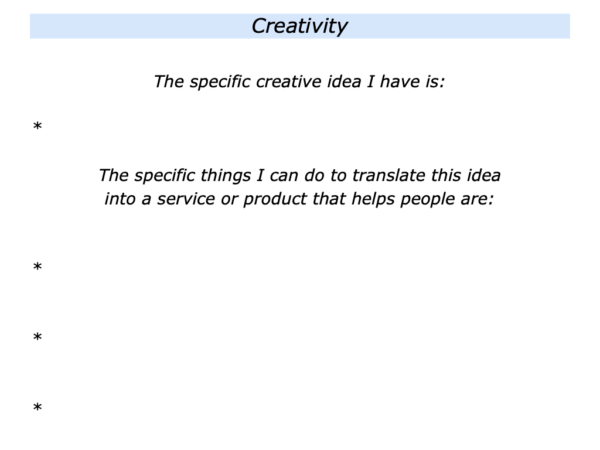
Customers
Creativity is fun. If a person wants to turn this into a business, however, the advice is:
“Go out and get your first three customers.”
This can feel counter-intuitive to some people. They want to get things absolutely perfect before going out to market. Certainly this is vital when developing a service or product that must work properly first time.
People who provide other kinds of services, however, can make sure that what they offer will be of high quality. They can then go out to work with customers and continue to improve the quality.
Taking this step can be difficult for some people, especially knowledge workers. They may say:
“But I don’t like to sell. It feels like I am imposing on people.”
Sometimes they can reframe this in another way. Such people don’t like to sell. But they do like to share their knowledge in a way that helps potential customers to succeed. They can then say:
“I want to help people to succeed.”
Before taking this step, it is important to know how to position a service or product to potential buyers. If you aim to offer something to an organisation, for example, you can clarify how it will help them to improve their profits, product quality or people.
The key is to focus on the customers rather than yourself. As ever, it is about them, not about you. Trusted advisors, for example, show they understand people’s goals. They then provide advice that enables them to achieve success.
Sometimes this can involve simply going and sharing knowledge that can help people to succeed. Imagine that you want to follow this route in your own way. The aims may be:
To clarify the challenges that potential customers may be facing or the goals they may want to achieve;
To find a way of reaching potential customers that fits your values system;
To pass on knowledge and practical tools that people can use to tackle their challenges or achieve their goals.
Different people follow this approach in different ways. Looking at my own work, I have tended to do this for free. Then, at some point, a person may say that they want to take this further on a paid basis.
But other people will feel more comfortable with other approaches to getting work. Let’s look at two possible ways.
The Shop Window Approach
This approach involves a person creating a shop window for their work. They may publish articles, produce a newsletter, make films or create a compelling website. This can increase their credibility and show the value of their work.
The Trojan Horse Approach
This is an approach that it is possible to use to start working with customers. The following section explores how this can lead to doing superb work.
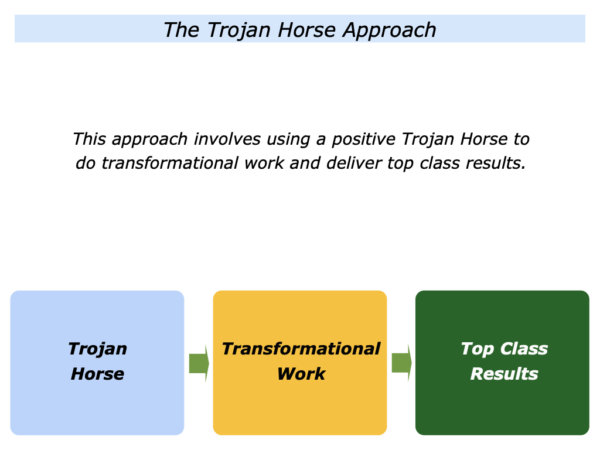
Let’s look at some examples of using a positive Trojan Horse. The first example is one that applies to people who work in the mentoring and coaching field.
Such people sometimes need to have a Trojan Horse that gives them the chance to begin doing such work. In the past some may have found a way in by inviting individuals to do psychometric tests.
The results of the test then provided a framework for having a conversation with a person. The test was just an opener. The quality of the mentoring or coaching depending on the quality of the conversation in the session.
During the 2008 recession I worked with some coaches who said they wanted to do transformational work with individuals. Some found that the market dried up, however, or that such one-to-one work was seen as a luxury.
We therefore explored how they could use a positive Trojan Horse. One approach was to do project work that could help organisations during the tough times.
Some took this approach with their existing customers and they helped to deliver top class results. It also led to them doing one-to-one work.
People need to choose a Trojan Horse they believe in. Looking at my own work, I often started working with organisations by providing workshops that helped people to build super teams. These then led to people having one-to-one sessions.
The Building A Successful
Prototype Approach
The Trojan Horse approach can also be used to shift a culture. The aims can be:
To build a successful prototype that shows the principles that an organisation can follow to achieve future success;
To then help other parts of the organisation to follow these principles in their own ways to achieve success;
To produce success stories that highlight how people have followed the principles and delivered success.
The successful prototype is the Trojan Horse. With the backing of the organisation’s leaders, the principles can be spread to transform other parts of the organisation. Eventually these principles may become the norm and enable the organisation to achieve future success.
Let’s return to the topic of reaching customers. It is vital to follow your natural style and, if possible, help people to succeed.
Bearing in mind the service or product you want to offer, try tackling the exercise on this theme. This invites you to complete the following sentences.
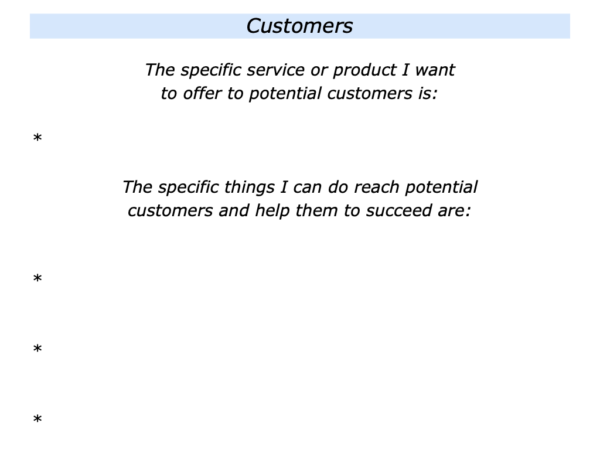
Cash
People get satisfaction from doing good work but sometimes it can also be helpful to get a salary. This can put food on the table and also provide the platform for their future development.
Freelancers often remember the satisfaction of sending their first invoice and getting money in the bank. If you want to follow the fulfilling road and get funding, it is good to develop commercial awareness.
Different people do this in different ways. My own approach may be seen as being uncommercial. It has been to visit potential customers and spend a couple of hours with them once or twice.
The aim is to pass on practical tools they can use to succeed. If they would like a third visit – or want to take things forward in other ways – we explore the possibility of funding.
Because I am not good at talking about money, I have tended to use the phrase:
“Would there be any possibility of any funding?”
You will, of course, take this step in your own way. You may not want to make lots of money but may need to get cash in the bank. This can help to maintain your chosen lifestyle and also invest in shaping the future.
There are many ways to do fine work. One approach is to get the right balance between creativity, customer and cash. This can help you to feel alive and also do satisfying work that helps people to succeed.
If you wish, try tackling the final exercise on this theme. This invites you to explore how you can perform superb work and also get cash in the bank. Here is the exercise.
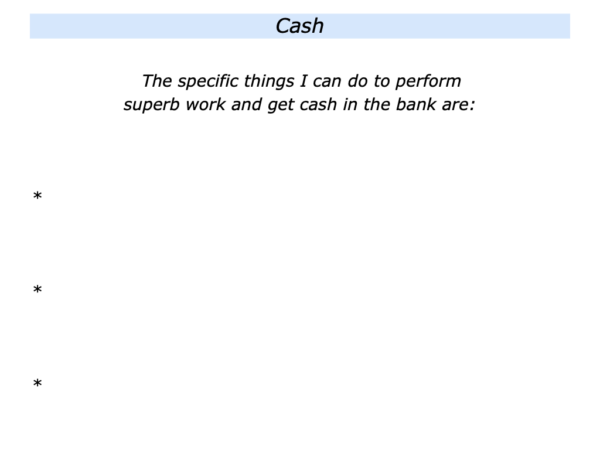






Leave a Reply